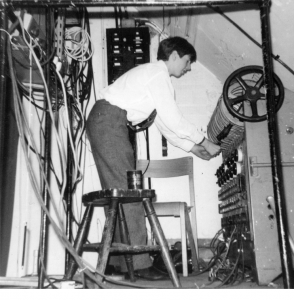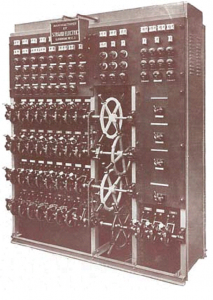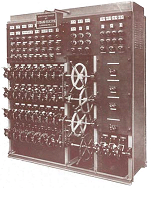No, not School Dinners but School Dimmers!
Geoff Fletcher mentioned that as a member of the Science VI at school – and with minimal acting talent, his role in the school play was to man the lighting console (in actuality a dodgy set of ancient vertical faders which got very hot indeed by the end of each act), and bunging six inch nails into the school main fuses to take the load.
Mike Jordan
You had modern dimmers!
(Click on the picture below to see larger version:
use your Browser’s BACK button to return to this page)
This was our original Strand interlocking board (but with a new Junior 8 board behind – that did a masterfade with a piece of wood stretched across the individual dimmers).
At about 16, I was wiring the stage including rewiring the Patt 23s with asbestos based cable and ordinary cables to the open air stage for a portable board!
No teachers anywhere to be seen of course and power tools in evidence.
Never be allowed now of course!
Geoff Fletcher
The seating arrangements look very similar to our set up! Never be allowed now – but didn’t we learn a lot from it all! And it was FUN!
Dave Mundy
In the mid-50s our stage dimmers were horizontal rheostats with pottery handles which got very hot and were cooled throughout the performance with lumps of cotton wool soaked in water!
Wouldn’t be allowed today either!
Dave Plowman
My school had dimmable fluorescents as the main hall lighting. In the 1950s. Massive great control unit.
Bill Jenkin
There were two phases at various points around our school hall and one apparently had the polarity wrong. The result was that instead of fading the house lights down we spectacularly managed to fade them up to 415 volts.
Dave Buckley
My old school had, from the early 1950s until well into the 1990s, a Strand Sunset control board (see picture below for a similar style of board).
(Click on the picture below to see larger version:
use your Browser’s BACK button to return to this page)
This used what were effectively open electric fire elements to control the lanterns. If you brought the fader up too fast, you could go through the endstop and be left with no control over the channel!
In to the bargain, it was a three phase board and taking the back panel off, you could get at the phase connections for the channels. Lighting wise, there was the usual footlights batten and three overhead battens each with three colours – usually red, green and blue, to give a sort of white when all were up. Strand Pat 23 and Pat 123 lanterns (with asbestos cables as mentioned) formed the main lighting with some Pat 234s and 264s.
At stage level, there were dip traps and high up on the walls, other output sockets – there was no cross patching facilities. The wall sockets had phase markings on them, but I don’t remember any on the battens or dip traps. I have often wondered if the battens were wired three phase – a colour on each phase.
We were left to our own devices when it came to stage work, although there was a highly regarded master who kept an eye on us – and we were all on first name terms with him.
About asbestos cabling – when one of the theatres up here in Dumfries was made to have its lighting updated, I acquired four Pat 123s and a couple of Pat 23s for the theatre I was involved with. After a rewire – the Pat 23s still had the original asbestos cable(!) – and a change of lamp base, they are still working quite nicely, thank you!
Geoff Fletcher
I think I used the word "faders" a little loosely when describing my experience on “A Midsummer Night’s Dream” at MDGS at the start of this school dimmer theme. I should have said "rheostats" as they were like the ones described but mounted vertically instead of being horizontal. They certainly got very hot!
Alasdair Lawrance
I do wonder how we got away with it all…..
I remember being under the school stage doing additional effects-type lighting with a mate, all run off a veritable stack of 15a and 5a round pin adapters. It got so bad we had to cool the stack with a hair drier to stop them getting too hot or melting. We’d wired more than one light into each plug as well!
Alec Bray
After leaving the Beeb and doing 4 years at the University of Liverpool, I then taught Maths and other things at a Boys’ comprehensive school in Reading.
At Christmastime, there was the usual show put on, by pupils and teachers, for the enjoyment of the whole school.
This one year, we had the usual stuff on stage – lights, music amps and other stuff, all run from a most decrepit dimmer board – sliding rheostats and such like – and various dip traps on the stage.
At the end of the show, the Christmas tree lights were to be switched on – the festivities can start! Whey hey!
The time came, the switch was thrown on cue – and everything went black. Look at the fuse in the 13 amp plug for the tree lights. That was fine. Must be the dimmer board. All the fuses there were fine. Back down the feed line we looked: everything we could see was fine and shipshape, no fuse blown.
Then the caretaker appeared, somewhat shaken. One of the big old main supply cartridge fuses in the boiler room had blown and shot itself across from one side to the other. Quite a bang.
Brian Curtis
I certainly remember the "good old"(?) Stand Junior 8 dimmers and being a "techie" back in my own school days I remember the tricks to "group fade" four (possibly more?) dimmers at a time with a "yard stick" (piece of 2"x1" batten).
After leaving the BBC I, too, became a teacher, of drama, and inevitably got involved in stage lighting as well.
In my first school (in 1975) we had the good old fashioned "Junior 8 dimmers" in the hall but in the recently built drama studio there were 2 x Strand Mini 2 thyristor packs (hard wired in). I persuaded the head to let me have a some money and with the help of a parent who was an electrician these were made "portable" with Reyrolle 30 Amp plugs and sockets and the the old dimmers in the hall scrapped!
A few years later in my next school I found the same situation! Except that the dimmer unit in the hall was a massive "interlocking dimmer unit" where you screwed individual dimmer levers down on to a bar and the whole lot were moved by turning a "ships wheel" at the end of the bar! Again a little bit of money and the school had some Tempus units installed and the old unit sold off for scrap!
However, like Alasdair Lawrence, says "I do wonder how we got away with it all…" one of our pupils very nearly didn’t!
The house lights in the hall were still controlled with a "rheostat dimmer" which was formed as quadrant arc with a large handle that rotated to control it. This was all housed on a metal mesh cage to allow air cooling! During one rehearsal for a production, Tony, one of my colleagues from the science department who was helping noticed one lad about to stick the metal handle of an "afro pick" comb through the metal grill casing on to the rheostat windings. Tony launched himself half way across the stage and rugby tackled the lad to the ground! The lad was most put out that he had been "frown to the ground init by a stupid teacher" and it was only when it was very carefully explained to him how close he had come to electrocuting himself did he calm down!
When I retired from teaching two years ago my drama studio still had a pair of Stand Mini 2’s which were just about running "on a wing and a prayer" (some channels were "kaput”!).
Mike Jordan
The dimmers shown in the photo were our Strand interlock with the screw down handle (a small version of the Grand Master installed at Golders Green Hippodrome when TV Theatre moved there whilst TVT was being refurbished).
(Click on the picture below to see larger version:
use your Browser’s BACK button to return to this page)
This was the small version of the Grand Master.
At Brighton Dome (for euro song contest), the lighting platform had a Grand Master next to a Junior 8 next to a couple of domestic dimmers.
I used to go to the Strand lectures from school in King Street Covent Garden – remember it each time on way to ROH – (one famous one showed how, if one is kept in, say, green light which is gradually changed to, say, blue, the mind gets totally confused and when white comes up, the truth dawns)
I still have loads of Tabs magazines and the 50th anniversary version.
Chris Pocock
Our Scouts used the old Questors Theatre in Ealing for our annual Scout Shows from WW2 to the time the new Questors was built. At that time the Questors Theatre was a corrugated iron ex Catholic Chapel.
In my teens (mid 1950s) I got involved with the lighting. There were half a dozens dimmers which were made from clay sewerage pipes containing brine sunk vertically into the ground. There was a fixed electrode in the base and another electrode dangling from a length of picture cord which passed over a quadrant with an attached lever. Operating the lever would lower the upper electrode into the brine and thus fade up the lights as it approached the electrode at the base.
If you overloaded the circuit the brine was likely to boil. Another problem was that if the level of the brine was a bit low, a fast fade up was likely to result in wet knees as there was no protection whatever.
The lighting ‘board’ was in the wings so it is surprising that with so many Cubs and Scouts milling about and rushing off stage that we never lost any of them!






